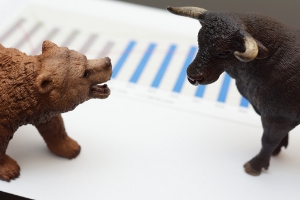 Over the past two weeks, markets have been down between 4 percent and 5 percent, and worries about the economy and inflation have been growing. As a result, I’ve been getting questions as to whether it is time to start worrying about the resumption of last year’s bear market. While the recent volatility may well continue, and there are indeed things to keep an eye on, I don’t think so. Here’s why.
Over the past two weeks, markets have been down between 4 percent and 5 percent, and worries about the economy and inflation have been growing. As a result, I’ve been getting questions as to whether it is time to start worrying about the resumption of last year’s bear market. While the recent volatility may well continue, and there are indeed things to keep an eye on, I don’t think so. Here’s why.
A Closer Look at Market Results
Both the S&P 500 and the Dow Jones Industrial Average bounced to a gain of about 2 percent to start February. They then dropped to even, moved to a gain of about 1 percent, and then dropped to where we are now, down about 1.5 percent. The Nasdaq has had a bumpier ride. It was up almost 5 percent at the start of the month, then it was down to a gain of about 1 percent, and it is now just above breakeven. What these results mean, of course, is that although the indices are down about 3 percent to 4 percent from their peaks during the month, for February as a whole, they are only showing small declines.
You see the same thing if you go back three months. There was even more volatility, with declines from the starting point of about 5 percent for the S&P in December, followed by a bounce to gains of about 3 percent early this month, and then the current result where the S&P is down 1.1 percent over the past three months. And for the past six months? We see the same thing with even more volatility: the S&P was down about 12 percent in October, but only down 1.9 percent from that starting point now.
Back Where We Started
The takeaway from the market results is simply this: over the past six months, the past three months, and the past month, the market (per the S&P 500) has ended up pretty much where it started. There was a bit of a roller-coaster ride, but the downswings bounced back. We saw similar results for the Dow. And while the Nasdaq did worse, down a bit more than 6 percent, this result again is a substantial recovery from the earlier drops. Yes, we saw real volatility. But in the end, markets wound up pretty close to where they started.
So, despite everything that has happened in the past six months—recession worries, inflation rebounding, the Fed continuing to raise interest rates, the pending debt ceiling confrontation, companies reporting earnings declines, and so on—the market has stayed at about the same levels. Most of the market decline that made the current bear market took place in the first half of 2022. Since then, we have just been bouncing along. The decline we have seen this month is more apparent than real.
What to Expect Next
So, what does this tell us going forward? First, over that six-month period, the market has been resilient to an incredible array of bad news, including a rebound in inflation and interest rates, probably the most damaging possibility. Second, much of the bad news going forward is already priced in, especially for the Fed and rates. Third, any significant further declines would depend on something even worse than anyone is now actively discussing happening. That is all good news.
Low Expectations May Lead to Positive Surprises
When expectations are already low—a recession, continued war in Ukraine, growing confrontation with China, rising inflation, a hawkish Fed, the debt ceiling, and so on—there is usually more upside than down ahead. While more bad things could happen (and likely will), we will also get some positive surprises. I look at the pullbacks in recent months and the subsequent recoveries as the market looking at all the bad news and deciding that, despite everything, stocks are still reasonably valued. And if that is the case? Once the bad news starts to abate, the market can rally.
That rally is not likely to happen anytime soon. We can expect more volatility and more sideways movement over the next couple of months because that bad news will not diminish that quickly. But as the year progresses, the prospects remain more positive than the headlines suggest.
Are there things to worry about and watch? Certainly. But because we are worrying and watching, they are already priced into the markets. It is the stuff we don’t expect that will move markets further. And with expectations this low, any surprises may well be positive.
Keep calm and carry on.


 Print
Print

